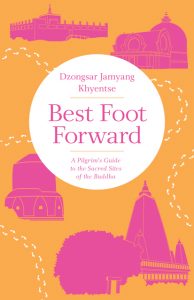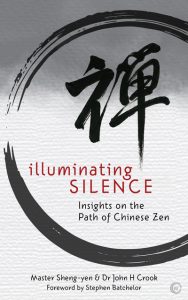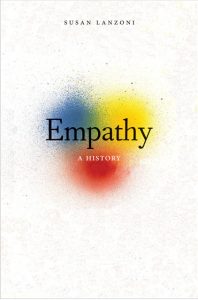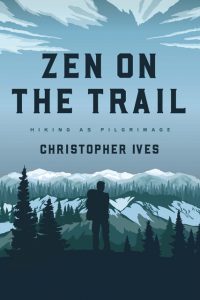 Pilgrimage is not an adventure to a foreign land, travel writer Pico Iyer has told us, but a “journey into reality.” In Best Foot Forward: A Pilgrim’s Guide to the Sacred Sites of the Buddha (Shambhala Publications, Aug. 2018, $16.95, 168 pp., paper), the well-known Tibetan Buddhist lama and filmmaker Dzongsar Jamyang Khyentse Rinpoche invokes this sentiment as he explains the whys and how-tos of pilgrimage in a short survey of the Buddhist holy places of India.
Pilgrimage is not an adventure to a foreign land, travel writer Pico Iyer has told us, but a “journey into reality.” In Best Foot Forward: A Pilgrim’s Guide to the Sacred Sites of the Buddha (Shambhala Publications, Aug. 2018, $16.95, 168 pp., paper), the well-known Tibetan Buddhist lama and filmmaker Dzongsar Jamyang Khyentse Rinpoche invokes this sentiment as he explains the whys and how-tos of pilgrimage in a short survey of the Buddhist holy places of India.
Rather than provide historical information or travel tips, Dzongsar Khyentse Rinpoche offers dharmic reflections and practice instructions related to each site. In Kushinagar, the place of the Buddha’s passing, for instance, he advises contemplating the reality of impermanence and taking advantage of the opportunity to practice before we’re no longer able to. Besides Kushinagar, his list includes Lumbini, the place of the Buddha’s upbringing and initial renunciation; Bodhgaya, where he achieved enlightenment; Sarnath, where he gave his first teaching; and Rajgir and Nalanda, prominent sites in the development of Mahayana Buddhism.
Best Foot Forward is useful for deepening a pilgrimage experience without having to rely on an in-person guide. Throughout, Dzongsar Khyentse Rinpoche reminds us that by visiting the actual places touched by the historical Buddha—an ordinary being—we realize that the goal of liberation is within reach for us too.

Testimony to the enduring influence of the Chan Buddhist teacher Master Sheng Yen (1930–2009) is evident in the reissuing of Illuminating Silence, now subtitled Insights on the Path of Chinese Zen (Watkins Publishing, July 2018, $17.95, 197 pp., paper). First published in 2002, this valuable collection of transcripts gives us a close-up view of two retreats held for Western dharma students in 1989 and 1995 at the Wales center founded by Sheng Yen’s first Western dharma heir, John Crook.
Master Sheng Yen famously held dharma transmission in both the Caodong and Linji lineages of Chinese Zen, which are known to many Westerners only in their Japanese forms—Soto and Rinzai—and are often thought of as mutually exclusive styles. But these retreat accounts show how Sheng Yen expressed the expansive options traditionally known to Chinese Chan. He drew on both traditions to provide students with a range of relaxing and concentrating practices, from breath counting to koan-like questions (huatou), leading to the open, aware state of “silent illumination” that is associated with the Caodong school (and later with Dogen’s shikantaza, “just sitting”).
The book includes Dr. Crook’s commentary and personal recollections as well as an abbreviated autobiography of Master Sheng Yen, a glossary, and a foreword by Stephen Batchelor.
 Buddhists are no strangers to learning about lovingkindness and compassion. But what about their cousin, empathy? Empathy: A History (Yale University Press, September 2018, $30, 408 pp., cloth), by Susan Lanzoni, a historian of the mind sciences, tracks the surprising development of the word from the early 20th century on and reflects on the role of the concept in Western society.
Buddhists are no strangers to learning about lovingkindness and compassion. But what about their cousin, empathy? Empathy: A History (Yale University Press, September 2018, $30, 408 pp., cloth), by Susan Lanzoni, a historian of the mind sciences, tracks the surprising development of the word from the early 20th century on and reflects on the role of the concept in Western society.
Empathy is now broadly understood as our capacity to grasp and share the feelings and thoughts of others. But our use of the term began, Lanzoni tells us, as a translation of the German word Einfühlung, literally “in-feeling,” which described the way that spectators’ feelings of emotion or movement could be projected into objects of art or nature. From there, the concept of empathy transformed, eventually becoming a scientific subject to be researched, as well as a widely called upon antidote for personal, political, and cultural ills.
To study empathy is to pay attention to the ways we mark self and other, Lanzoni says, in a pursuit that will seem familiar to dharma practitioners. For while we may like to think of empathy as a means of relating to others, it’s also a way of defining boundaries of difference. “To see another accurately,” she writes, “means to recognize that I am not you.” Ultimately, Lanzoni’s goal is not to establish a universal definition for the term but to home in on its subtlety, allowing its myriad renditions to enrich our contemporary understanding of interconnection.
 Lifelong outdoorsman Christopher Ives brings walking meditation to a new level in Zen on the Trail: Hiking as Pilgrimage (Wisdom Publications, Sept. 2018, $17.95, 192 pp., paper). Pulling thoughts from a variety of cultural and academic sources, Ives casts a wide net when discussing nature’s transcendent qualities, allowing readers to glean their own eclectic connections to nature. But as a professor of religious studies, he also draws a parallel between trail hiking and committing oneself to the Zen Buddhist path. Loosely following the model of Joseph Campbell’s hero’s journey, Ives tracks the spiritual progression represented by a hiker’s “pilgrimage,” from stepping out the door and leaving behind social identifiers of self to returning home as a changed, more grounded individual.
Lifelong outdoorsman Christopher Ives brings walking meditation to a new level in Zen on the Trail: Hiking as Pilgrimage (Wisdom Publications, Sept. 2018, $17.95, 192 pp., paper). Pulling thoughts from a variety of cultural and academic sources, Ives casts a wide net when discussing nature’s transcendent qualities, allowing readers to glean their own eclectic connections to nature. But as a professor of religious studies, he also draws a parallel between trail hiking and committing oneself to the Zen Buddhist path. Loosely following the model of Joseph Campbell’s hero’s journey, Ives tracks the spiritual progression represented by a hiker’s “pilgrimage,” from stepping out the door and leaving behind social identifiers of self to returning home as a changed, more grounded individual.
Ives’s thoughtful analyses of Zen meditation and the Zen view emerge seamlessly from a well of nature writing that recalls his hiking adventures around the world. Part Transcendentalist memoir, part Japanese Zen ethnography, and part dharma teaching, Zen on the Trail makes a bold vow: to “help us realize our embeddedness in nature and, ultimately, realize ourselves as nature.”